Rivets are permanent mechanical fasteners. They are used to join two or more materials. There are three most common types of rivets which are solid rivets, blind rivets (like pop rivets), and semi-tubular rivets.
Key Takeaways of the article:
- Rivet Definition
- Rivet Types
- Applications of Rivets
- Installation Techniques for Rivets
- Comparison of Riveting vs. Other Fastening Methods
What is a rivet?
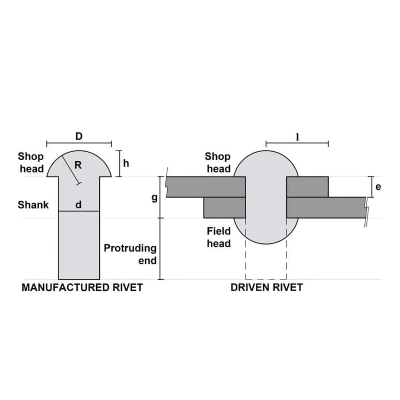
Rivets are the semi-permanent fasteners. They are used to join the different parts of applications. It consists of a cylindrical shape with a head on one end side and a tail on the opposite end.
Before being installed, the tail part of the rivets is inserted into the tool. Then it undergoes the process of applying compressive force. This force deforms the rivets into a flat shape, joining one part with the other.
These mechanical fasteners are usually made with mild steel, brass, copper, and aluminum. The manufacturers use rivets for several projects and the fabrication of industrial parts. For instance, bridges, sheet metal operations, structural frameworks, ships, and aerospace sectors.
Types of Rivets
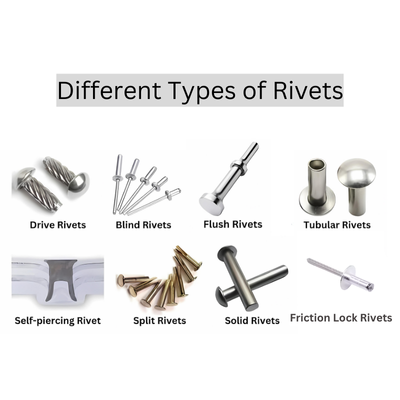
The rivets are available in various shapes and types with different uses. But we will try to discuss the specific types that are typically used in all kinds of works, from light to heavy performance parts. Let’s discover them:
- Solid Rivets
- Blind Rivets
- Drive Rivets
- Flush Rivets
- Self-piercing Rivets
- Split Rivets
- Tubular Rivets
- Friction Lock Rivets
Solid Rivets
Solid rivets are the classic methods to connect the material. These fasteners contain round shapes, also known as round rivets. Deforming the tail can be done via hammering or crimping tools. These rivets join the parts while making them tamper- and vibration-proof.
Steel, aluminum, and copper metals are suitable materials for the construction of solid rivets. These types of fasteners are used in applications of aircraft, aerospace, construction, household products, electronics, and more.
Blind Rivets
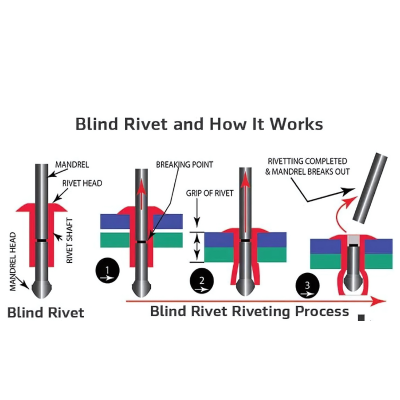
Blind rivets are renowned for pop rivets, constructed with cylindrical shapes with a head and mandrel running in the center. These are like tubular rivets that can be installed into drilled-hole parts.
Riveters and unique tools are chosen to place the rivets on working parts. The force is applied to push the mandrel through the rivet. In this way, force expand the tube between the tool and mandrel part to lock the sheet.
Blind rivets are inaccessible and used to join one side of parts. They reign supreme shear and tensile strength. The common applications of these rivets are shipbuilding, electronics, military, aerospace, and home applications.
Drive Rivets
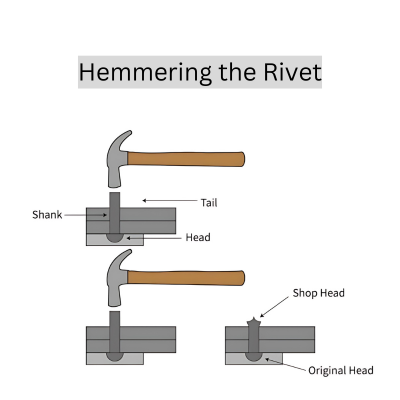
The drive rivets are similar to blind fasteners. They are built with a short mandrel through the center of rivets. The manufacturers can secure the drive rivets using a hammer or backing block tool.
These rivets can be used to fasten the applications of automotive components, architectural panels, and masonry work. They do not puncture the holes of blocks, panels, or sheets during the fastening process.
Flush Rivets
Flush rivets are designed with heads that lie flush with the metal surfaces to be fastened. They are also known as countersink rivets. That minimizes the aerodynamic drags and maintains the smooth surfaces.
The manufacturers use flush rivets for applications where appearance is a concern. These shafts are commonly used to fabricate external parts of aircraft and other industrial applications, like automotive and marine.
Self-piercing Rivets
Self-piercing rivets are constructed with bevel drill ends or chamfered pokes. These categories of rivets can be assembled on parts without drilling holes or puncturing the surface.
The manufacturers place both components on the press. They insert self-piercing rivets into the blank holder. Then this holder exhibits the force by pressing the rivets on the top side of the part.
The operators stop piercing the rivet until its half part is embedded in the second part. It is the fastest procedure for giving watertight or gas joint connections used in aerospace sectors.
Split Rivets
The split rivets or bifurcated rivets are fabricated by splitting the shaft or its opposite ends into two separate legs. Parts with pre-drilled holes are combined through split rivets. A hammer is used to flatten the split legs of rivets.
Soft and lightweight materials can be joined through these rivets, like plastic, textile, and thin metal sheets. However, they are not a good choice to fasten heavy-performance items.
Tubular Rivets
Tubular rivets basically demonstrate the tube-shaped fasteners. These shafts consist of a head on one end, a shank, and a partially hollow tube on the opposite side.
Tubular rivets do not require high compressive force to deform, unlike solid ones. You can join any pieces using cold-forming technology, where the walls of the hole flatten outward to join the parts.
This rivet is the preferred option among commercial applications of electrical devices, HVAC ducting, and other low-risk parts.
Friction Lock Rivets
Friction lock rivets are the types of blind rivets that are made in a cupola or countersunk form. These rivets are also called self-plugging rivets. They are like bolts that use the internal pressure of the stem to expand the shaft. The shafts of this rivet snap on the lower surface of parts because of the presence of high tensions. The manufacturers use friction lock rivets to repair aircraft applications like lights.
Rivet Applications
Over time, industries have leveraged rivet fasteners to fabricate their multiple components with strong joints. Securing the multiple parts, rivets eliminate the internal movements and vibrations.
Industry-Specific Applications
- Applications in Aerospace
- Automotive
- Construction sectors.
Applications in Aerospace
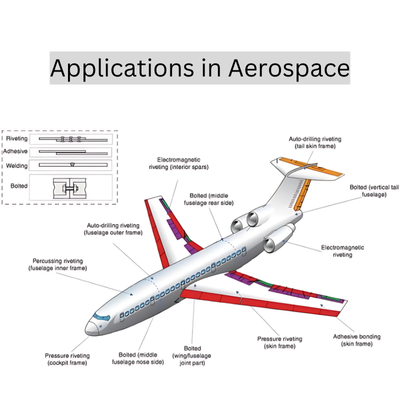
Generally, strong and corrosion-resistant materials like aluminum, copper, and steel are used in aerospace applications. The engineers assemble the parts of the aircraft by applying rivet fasteners. These rivets are usually made with aluminum composites, enabling the lightweight features for non-structural parts. They align and form multiple parts, including:
- Fuselage Frames
- tail skin frame
- Doors and Hatches
- Interior spars
- cockpit frame
- Landing Gear Attachments
- Engine Nacelles and Mounts
- Wing Structures
Automotive
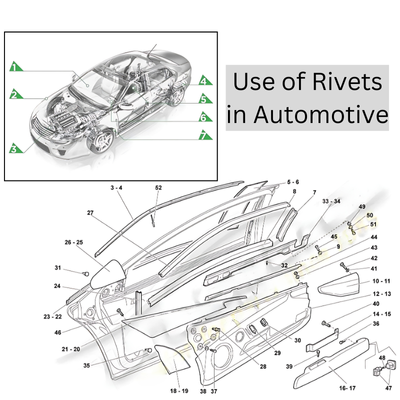
Low-weighted rivets manufactured with aluminum alloy are the preferred choice of engineers to make automotive parts light in weight. The diverse use of rivets includes deforming to join the aluminum, steel, and copper parts. These are the parts of vehicles where rivets are applied:
- Body panels
- Chassis and Frame
- Battery Enclosures
- Suspension Parts
- Crash structure, Crumple Zones
- Doors and windows
- Exhaust Systems
Construction Sector
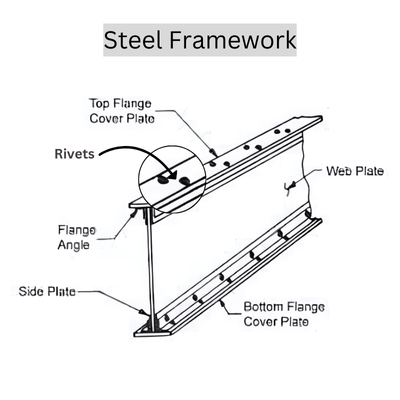
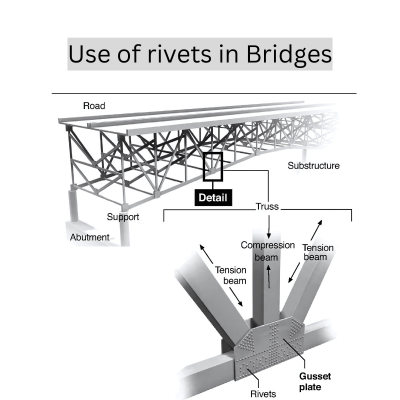
The joining of structural and non-structural parts can rely on rivets. They provide high efficacy for construction applications. Rivet fastening is the easiest step to work for joining the several components. you can leverage this to fabricate the following parts:
- Steel Framework and Beam
- Bridges
- Metal Roofing
- Facade and Cladding Systems
- window and Curtain Walls
- Handrails and Guardrails
- Stairs and Fire Escape
The Riveting Process
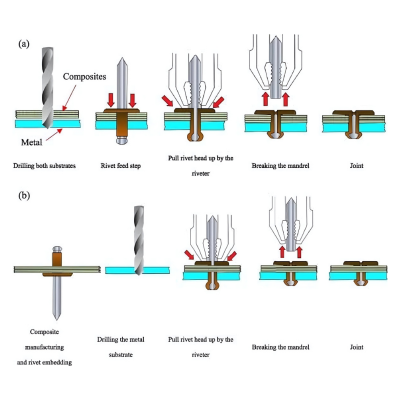
Rivet Installation Techniques
Always try to follow each step without skipping to achieve the durable and secure joints of parts with rivets. These steps may include:
- Tools
- Step-by-Step Installation Process
Tools
- Rivet guns
- Bucking Bars
- Drills and clamps
Step-by-Step Installation Process
- Preparation
- Rivet Placement
- Riveting
- Quality Inspection
Preparation
Clean the surface of the parts that are subject to assemblage together through riveting. Use a mixture of water and detergent to remove any sticky marks and stains from metal.
Moving forward, mark the metal with the correct points and a slightly bigger dimension than the rivets. So that you can make the holes through drilling.
Rivet Placement
Shape the rivet heads using bucking bars. Then take the rivet gun to begin the riveting process. Place the rivet’s opposite end in the gun slots. You can adjust the size of gun bolts to match the size of rivets.
Riveting
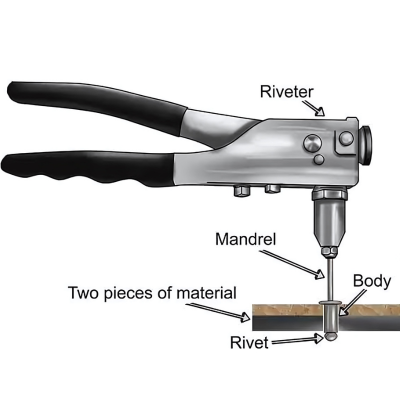
Place both fastening parts together, equivalent to the drilled holes. Then grab the rivet gun with inserted rivets to place on the hole surface. Press the gun manually to pull the tail against the head of the rivet until it flattens and the tail breaks.
Quality Inspection
Inspect the parts thoroughly to identify any cracks or breakage, ensuring the flush finish. These additional steps can assure the quality guarantee against structural failure. That is necessary for safety concerns.
Inspection Methods
- Visual Inspections
- Ultrasonic Testing
- Shear Testing
Visual Inspections
The quality management team should scrutinize each part deeply. They can check the faults of cracked rivet heads, poor alignment, or surface damage without using any specific tool.
Ultrasonic Testing
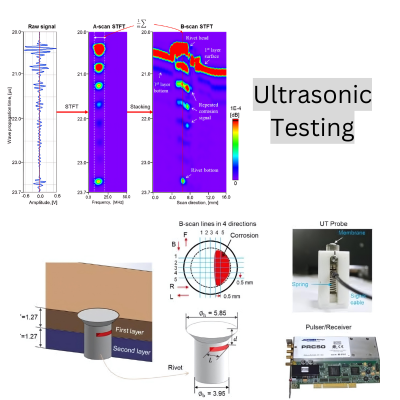
Use ultrasonic tools to inspect complex and detailed parts. The non-destructive testing technique will identify the false riveting, exhibiting the rays across the joined metals.
Shear Testing
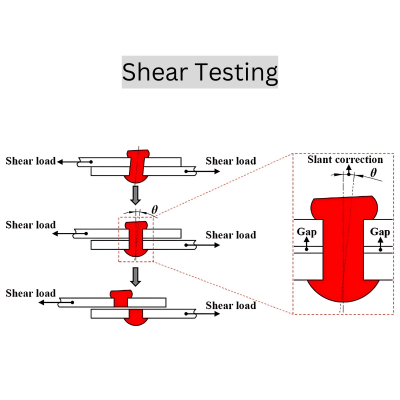
Check the strength of the fastened parts by applying the shear force. It will assure you that either fasten parts withstand operational pressures or not.
Comparative Analysis of Riveting vs. Other Fastening Methods
| Aspect | Riveting | Welding | Adhesive Bonding | Bolts |
| Method | Mechanical fastening using rivets | Fusion process joining metals | Chemical bonding with adhesives | Inserted and tightened with tools |
| Primary Use | Permanent, for metal structures, aircraft, bridges | Permanent, for structural and heavy-duty joints | Semi-permanent, used for mixed materials | Structural and removable metal joints |
| Materials Joined | Metals, composite materials | Metals (e.g., steel, aluminum) | Metals, plastics, composites | Metals or similar materials |
| Strength Characteristics | Good shear strength, moderate tensile strength | High tensile and shear strength | Moderate strength; good for non-load-bearing | High tensile strength and shear strength |
| Heat Involvement | No heat required | Requires high heat for melting | No heat, cured by time, pressure, or UV | No heat required |
| Installation Process | Insert rivet, use rivet gun/bucking bar to form head | Align materials, weld edges with high heat | Apply adhesive, press surfaces together, and cure | Insert bolt, tighten with a wrench or other tools |
| Removal Process | Drill or cut the rivet to remove | Requires cutting or grinding | Solvent or heat to weaken bond, peel off | Unscrewed using tools (wrench, ratchet, etc.) |
| Inspection Requirements | Visual, ultrasonic, or shear testing | Visual and NDT (ultrasonic, radiographic) | Visual, sometimes tensile testing | Visual inspection, torque testing |
| Advantages | High durability, no heat distortion | Very strong, continuous joint | Suitable for a variety of materials, flexible bond | Easy to install and remove, allows disassembly |
| Disadvantages | Time-consuming, requires precise alignment | Potential for heat distortion, irreversible | Sensitive to environment (e.g., moisture) | Prone to loosening under vibration, needs retightening |
Cost comparison of riveting, welding, adhesive bonding, and bolting
| Joining Method | Approximate Cost per Joint |
| Riveting | $0.10 – $1.00 |
| Welding | $0.50 – $5.00 |
| Adhesive Bonding | $0.25 – $2.00 |
| Bolting | $0.20 – $1.50 |
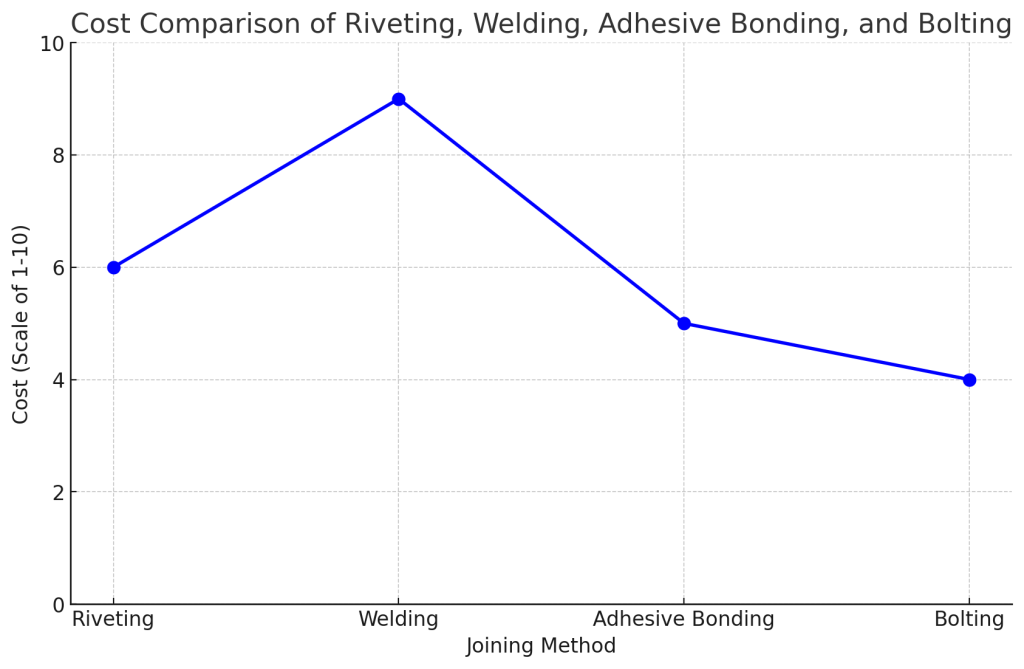
This line graph displays the price fluctuation of riveting, welding, adhesive bonding, and bolting methods on a scale from 1 to 10. Welding fastening is the most expensive method. It involves specific setup, tools’s expenses, and labor costs. In contrast, bolting is an economical choice for all types of sectors. Riveting and adhesive bonding prices indicate moderate costs falling in between.
Innovative Riveting Technologies
Advancements in Riveting Technologies
Robotic and Automated Riveting Systems
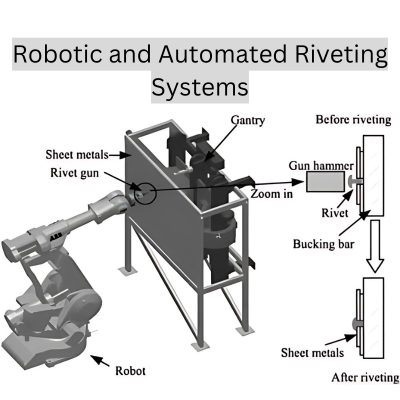
Riveting techniques have been improved by introducing robotic arms and CNC (computer numerical control) machines. These tools provide precise and accurate placement with consistent pressure on every deformed rivet.
Rivet Calculators
Rivet calculators make it easier to fasten the different parts. These measuring tools consider the exact size, construction material, or space values. In addition to this, they streamline the precise load pressures, thicknesses, and strength of rivets. The rivet calculator enables optimized options for durability and safety.
Impact on Efficiency and Quality:
The advancements in manufacturing and riveting processes bring quality assurance factors. They decrease the operation time and produce large-quality parts. Using a robotic arm and calculators prevents metal fatigue issues and allows quick production with accuracy.
Conclusion:
Rivets are the greatest fasteners that are not more expensive than welding. They provide durable joints with sufficient finishes. These rivets can be made from various materials like steel, aluminum, or copper. Besides, rivets are of multiple types, with their specific use for applications. Following the essential steps of riveting technique and adapting modern systems enable you to achieve the desired output.

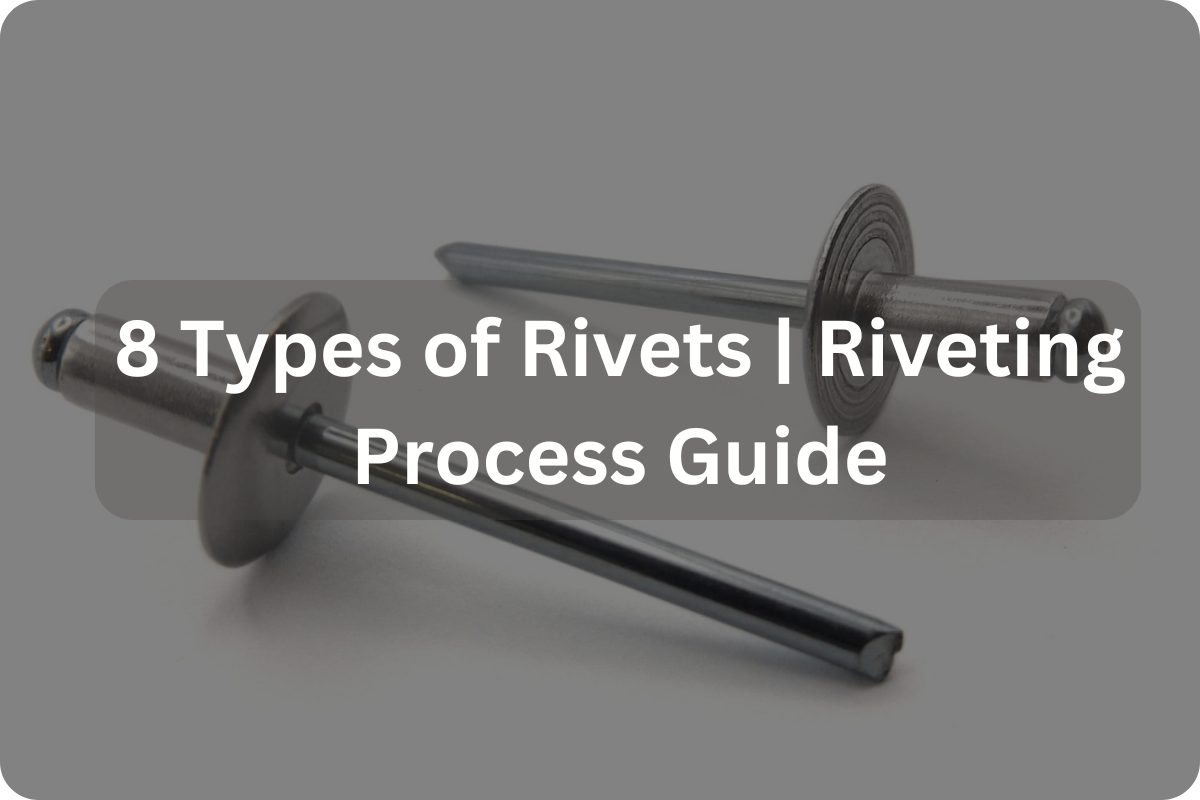
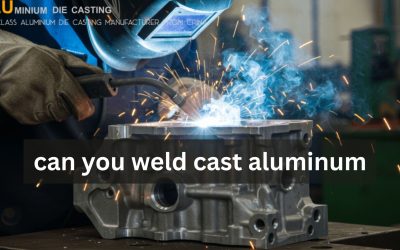


0 Comments